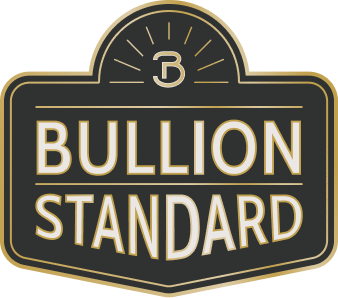Key Differences Between Gold vs Silver Investments
By Bullion Standard ·
7 min read
Investing in precious metals like gold and silver is a time-honored strategy for those seeking to diversify their portfolios and protect their wealth from rising inflation.
However, deciding which metal to invest in can be challenging. The choice isn't always clear-cut and depends on a variety of factors. For example: Are you aiming for stability, or do you prefer the potential for higher growth? Do you want to preserve your wealth, or are you willing to accept more risk for the chance of greater returns?
At Bullion Standard, we understand the nuances of investing in precious metals and want to offer our expertise to help you choose wisely.
This article will break down the critical differences between gold vs silver, so you can determine which precious metal aligns better with your financial goals, whether it's securing wealth or navigating market fluctuations.
Gold vs Silver—Which Is Right for You?
Are you considering adding precious metals to your investment portfolio? If so, you're likely weighing gold or silver.
Both have their advantages, but which one suits your financial strategy? Let’s break down the key differences between gold vs silver.
Historical Performance
Gold’s Historical Stability
Gold has long been seen as a store of value. Its price tends to rise during times of economic instability. This historical stability makes gold a popular choice for those looking to preserve wealth.
Take the 2008 financial crisis, for example. Gold prices soared as investors sought safety. Similarly, gold prices hit a record high of $2,152 per ounce earlier this year as investors anticipated Federal Reserve interest rate cuts amid economic uncertainty.
Both scenarios reinforce gold’s role as a financial safety net, offering stability and peace of mind when the economy gets unpredictable.
Silver’s Industrial Uses
Silver, while also a store of value, has more industrial uses. According to The Silver Institute, silver's global industrial demand reached a record high of 556.5 million ounces in 2022, driven largely by the growing adoption of green technologies like solar panels and electric vehicles.
This means silver's price is influenced not only by investor demand but also by industrial demand. This dual demand can lead to higher price volatility compared to gold.

Market Behavior
Gold: A Hedge Against Inflation
Gold is often seen as a hedge against inflation. When the value of paper currency falls, gold tends to hold its value or even increase. This makes it a popular choice during periods of high inflation or when confidence in fiat currencies (like the US dollar or Euro) declines.
Silver: Higher Volatility, Higher Potential
Silver’s price is more volatile than gold’s due to its smaller market size and industrial demand.
This dual role as both an industrial metal and an investment asset can cause silver’s price to react more sharply to changes in the global economy, offering greater opportunities—and risks—for investors. For instance, the demand for silver is sharply increasing in 2024, with record highs anticipated in the near future.
Gold and Silver Prices
Gold Price: Higher Cost per Ounce
Gold is more expensive than silver, making it harder for some investors to buy gold in large quantities.
However, because of its concentrated value, even a small amount of gold can represent a significant portion of your investment portfolio. This makes it easier to store and transport without taking up much space.
Silver Price: More Affordable
Silver is much more affordable than gold, allowing investors to purchase more ounces for the same amount of money. This lower cost of entry makes silver accessible to a broader range of investors, particularly those who are just starting or want to diversify without over-committing.
Additionally, silver’s affordability often appeals to those interested in buying physical assets, like silver coins or bars, to hold as part of their tangible wealth.
Liquidity
Gold: Highly Liquid
Gold is one of the most liquid assets in the world, meaning it can be easily bought or sold almost anywhere. This high liquidity makes gold an attractive option for those who may need to quickly convert their investment into cash.
Silver: Also Liquid, but Market Can Be Thinner
Silver is generally considered a liquid asset. However, selling large quantities of silver can be more challenging than gold because the silver market is smaller and less liquid.
Additionally, the thinner market for silver can result in price fluctuations, especially during times of economic uncertainty or low demand, making it harder to predict the exact value you’ll receive when selling.
Diversification
Gold: A Core Holding
Many investors consider gold a core holding in their portfolios, and for good reason. Its ability to retain value when other assets may falter provides a solid foundation for any investment strategy.
Beyond stability, gold's historical performance demonstrates its resilience, often appreciating when fiat currencies or equities are under pressure, which makes it an ideal anchor for long-term wealth preservation.
Silver: A Complementary Asset
Silver, on the other hand, is typically viewed as a complementary asset rather than a core holding.
Its appeal lies not just in its status as a precious metal but also in its widespread industrial applications, which can drive demand and influence its price independently of gold.
Including both silver and gold in your portfolio can provide a balance of stability and growth potential.

Tax Considerations
Gold: Long-Term Capital Gains
In the U.S., gold is considered a collectible, which subjects it to a higher long-term capital gains tax rate of up to 28%. This rate is notably higher than the 15% or 20% typically applied to other investments like mutual funds and exchange-traded funds (ETFs).
As a result, investors should factor this higher tax rate into their financial planning, especially when considering gold for long-term investment.
Silver: Same Tax Treatment as Gold
Silver is taxed similarly to gold in the U.S., classified as a collectible with a maximum long-term capital gains tax rate of 28%. This means that, like gold, the profits from selling silver after holding it for more than a year will be taxed at this higher rate, regardless of your income bracket.
This can make silver less tax-efficient compared to other investments, such as stocks or bonds, which typically benefit from lower capital gains tax rates.
Which Is Better: Gold vs Silver?
The decision between gold and silver largely depends on what you're looking to get out of your investment.
Gold is known for its stability, making it a reliable store of value that can anchor your portfolio during turbulent times. Silver, while more unpredictable, offers the potential for higher returns due to its industrial demand and lower price point, which can lead to significant gains during market upswings.
Many investors choose to diversify by holding both gold and silver. This strategy can strike the right balance between security and opportunity, so you’re well-positioned no matter what the market does next.
Diversify Your Portfolio With Bullion Standard
Considering the benefits of gold and silver for your investment strategy?
Bullion Standard is here to help you navigate the market, offering expert advice on how to balance stability and growth in your portfolio. Visit Bullion Standard to start building your wealth today.






















